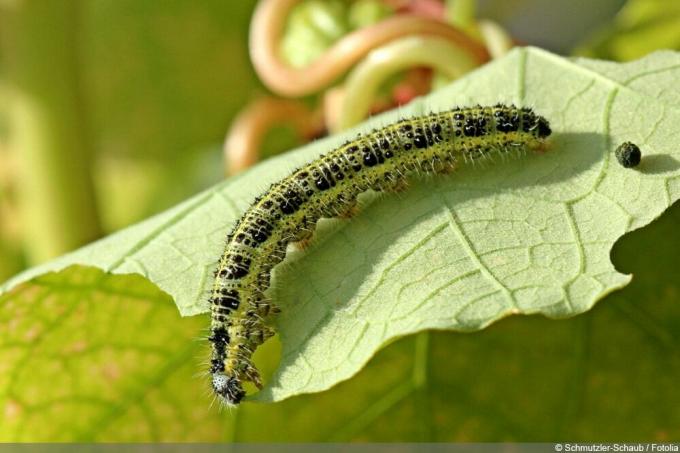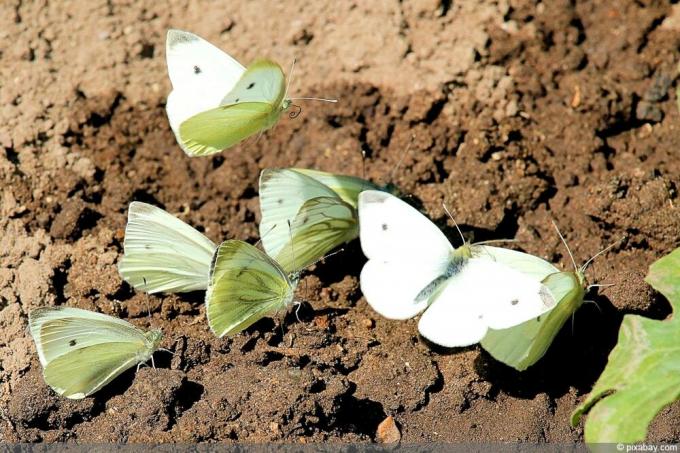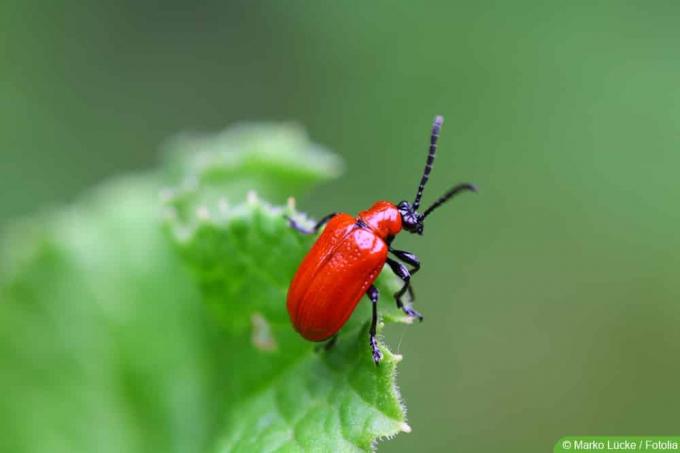

Table of contents
- Recognize the cabbage white butterfly
- Images of damage in the event of an infestation
- home remedies to combat it
- collect
- Tobacco Ash and Stone Powder
- Vegetable broths made from tansy and wormwood
- Cold water extracts from tomato leaves
- Natural predators
- Prevent effectively
- cultural protection networks
- comply with crop rotation
- grow mixed crops
The cabbage white is one of the most widespread butterflies and a vegetable pest that should not be underestimated. Almost all types of cabbage serve as host plants for their caterpillars. Here they can cause great damage in a very short time. This in turn can result in enormous crop failures. This makes it all the more important to start fighting at the first sign and to prevent a new infestation.
Recognize the cabbage white butterfly
Damage from the cabbage white from the white butterfly family can occur in the period from May to August. The whitish-yellow, large cabbage white (Pieris brassicae) lays its eggs in clutches of up to 20 pieces. The caterpillars that hatch from this are up to five centimeters long, are mottled yellow-green and black. In contrast, the somewhat yellowish, small cabbage white (Pieris rapae) lays its eggs individually. Its caterpillars are light green and about 3.5 cm long. The best protection against this pest is a bow. If it is already too late for that, you should become active at the latest when the white moths are buzzing through the garden, because then it usually doesn't take long before the cabbage plants are swarming with caterpillars and the first feeding damage is visible become.
Images of damage in the event of an infestation
The large cabbage white lays its eggs on the undersides of the leaves of wild cruciferous plants, which the caterpillars then feed on for 3-4 weeks before finally pupating. Of particular importance are the second generation moths, which lay their eggs under the leaves of cabbage plants or nasturtiums and cause the typical feeding damage there. In contrast, the spectrum of host plants for the small cabbage white is much larger. In addition to cabbage plants and other cruciferous plants, these also include caper, nasturtium and foxtail plants. The caterpillars of the small cabbage white are not only limited to the leaves, but sometimes eat their way into the heart of the cabbage plants. The greatest damage usually occurs in July. If it is too late for preventive measures, it is essential to start fighting as early as possible, i.e. as soon as the first signs of an infestation appear.
home remedies to combat it
Fighting with home remedies can be particularly promising if the caterpillars of this pest have not yet eaten their way through to the inside of the plants. If they do, you can usually only dispose of the affected vegetable plants.
collect

The easiest method is certainly collecting the caterpillars. However, this only works in the case of an initial infestation or occasional occurrence of pests and before the cabbage hearts have formed. The longer you let the caterpillars do their thing, the greater the feeding damage. You should look out for the eggs of this moth from around June/July, which are usually laid under the leaves and then continuously for the hatched caterpillars. The eggs are easy to crush with your fingers. With gloves it's not quite as uncomfortable. Or you brush them off with a hand brush and dustpan.
Tip:
If collecting it with your hands is too time-consuming or disgusting, you can borrow a special vacuum cleaner for such activities. Occasionally they are offered as a loan in well-stocked nurseries.
Tobacco Ash and Stone Powder
If it is not enough to collect the caterpillars, you can try to drive them away with tobacco ash or stone dust or keep away. To do this, first moisten the plants with a watering can or garden hose so that the ash sticks to them. Then they are dusted with tobacco ash. As an alternative to tobacco ash, you can also spread a wafer-thin layer of stone dust over the plants.
Tip:
Oily products should be avoided if possible, as they can do more harm than good to the plants.
Vegetable broths made from tansy and wormwood
Another, very gentle way of fighting the cabbage white and its caterpillars is to use plant broths made from tansy and wormwood. The intense odors of both plants and the bitter substances of the tansy are particularly effective against the cabbage white.
- Blossoms, leaves and stems are used
- Best time for collecting is from July to August
- Suitable for making a broth, fresh and dried herb
- You need 300-500 g fresh or 30 g dried herb and 10 liters of water
- First, soak the herb in water for about 24 hours
- Preferably use rainwater
- Then the whole thing approx. Cook for 20-30 minutes
- Bitter substances and essential oils can thus be released from the plants
- Then let the mixture cool down
- After cooling, pour through a sieve
- Apply the ready-made tansy broth during the cabbage white butterfly’s flight season
- Undiluted on the soil around the plants, and spray the root collars
In June and July, wormwood broth is sprayed directly onto the cabbage plants and the soil in a ratio of 1:3 (1 part wormwood broth to 3 parts water). Anyone who wants to grow wormwood in their garden for the purpose of pest control should do so because of the unfavorable influence on neighboring plants but also for earthworms and other beneficial insects, always in a separate, secluded place in the garden do. For the same reason, wormwood should not be disposed of in the compost.
Tip:
Nettle broth is good for many things, but it is usually counterproductive against the cabbage white because it attracts butterflies, including the cabbage white moth.
Cold water extracts from tomato leaves
A cold water extract made from the stinging shoots (sterile side shoots) of tomatoes can be used to control the cabbage white butterfly or cabbage white. its expulsion are used. Here, too, the effect is based on the strong smell, which confuses or scares the pests. should deter.
- Prepare a cold water extract from fresh plant material
- To do this, soak about 1 kg of fresh tomato leaves or scallions in 10 liters of water
- Leave it for 1-2 days
- Then strain and store in sealable containers
- Mixture should not ferment under any circumstances
- Use the finished, undiluted brew shortly before and during the flight time
- Spray plants preferably in overcast weather

As an alternative to a cold water extract from tomato leaves, you can simply spread the leaves and/or shoots of tomatoes on the ground under the cabbage plants. However, new ones have to be refilled at regular intervals. The dried parts of the plant can safely remain on the ground, and thus serve as mulch and nutrient supplier.
Natural predators
Like most pests, the cabbage white has natural predators that can be used to fight both the moth itself and its caterpillars. In addition to birds, there is a certain type of parasitic wasp, the so-called cabbage white parasitic wasp.
- Cabbage white parasitic wasp is actually a braconid wasp (Cotesia glomerata)
- Braconid wasps are only 0.3 cm long
- The first three larval stages parasitize various caterpillars
- Including those of the large cabbage white
- Female braconids lay up to 150 eggs per caterpillar
- The larvae develop inside the cabbage white caterpillars
- Break through the skin of their host caterpillars just before pupating
- This will kill the cabbage white caterpillars
In addition to the use of brackish wasps, you can use an insect hotel to keep other useful insects in the garden lure your home garden and thus not only cabbage plants but also many other useful and ornamental plants from pests protection. In addition to supporting pest control, an insect hotel can attract important helpers for pollinating vegetable, fruit and berry trees. In addition, it is also useful for other predators such as e.g. B. to create suitable shelters for predatory and carabid beetles. These beetles like to use hiding places such as piles of stones, leaves and dead wood, tree stumps, moist areas under ground cover plants or with moss.
Tip:
Shrews, moles, hedgehogs and chickens also like to eat the cabbage white caterpillars.
Prevent effectively
The best protection against cabbage whites and especially their voracious caterpillars is prevention. The main aim is to prevent the moths from laying their eggs. The best way to do this is with culture protection networks and coordinated mixed cultures.
cultural protection networks
Crop protection nets or corresponding fleeces offer simple, inexpensive and effective protection against a large number of pests, such as e.g. B. the vegetable fly, the cabbage fly, the Colorado potato beetle, the gall midge and various pest butterflies such as the large and small cabbage white. They also offer protection from bird damage.
- Nets used should be fine-meshed (maximum 2 mm) and intact
- Should be deployed early or be stretched over vegetable beds
- Early means immediately after sowing or planting
- Time to apply around April
- Absolutely avoid loopholes for pests
- Dig the edges of the net into the ground all around
- Additionally weigh down with stones

Furthermore, the nets should remain on the beds for the entire cultivation period and care should be taken to ensure that there is sufficient volume, because the cabbage plants grow tall. If very close-meshed nets or even fleece are used, they should be used, especially in summer with large Exposure to heat should be opened and ventilated regularly to prevent overheating of vegetable plants avoid. In order to increase the effectiveness of these nets, crop rotation should be observed at the same time and mixed crops should be cultivated.
Tip:
Even if crop protection nets are relatively good at keeping cabbage white moths away, they are not a panacea against this or other pests. Regular inspection of the plants is nevertheless essential.
comply with crop rotation
Adhering to crop rotation is the basis for healthy, pest-free vegetables and a bountiful harvest. Adhering to crop rotation means that you don't grow the same types of vegetables over and over again in the same location year after year. Otherwise, it increases the risk of pest infestation. For example, cruciferous vegetables such as B. Cauliflower, kale and kohlrabi, can only be grown on the same bed again after four years at the earliest. This also applies to green manure with cruciferous plants, which should also be avoided. Good preceding crops for cabbage are e.g. B. Beans, peas, sweetcorn, celery and rye. The cabbage itself is a rather bad preceding crop.
grow mixed crops
There are many good reasons for mixed cultures. One of them is protection against the cabbage white butterfly or at least a reduction in infestation. Mixed cultures with strong-smelling plants are recommended, particularly to protect against this harmful butterfly and its caterpillars. These include celery, tomatoes, onions, elderberries, broad beans, leeks, borage, lettuce, spinach, marigolds, Privet, nasturtium as well as chamomile, basil, coriander, tansy, mugwort, rosemary, and sage Thyme. The natural defense of these plants against the cabbage white butterfly is based on the mustard oils they contain.
Tip:
In addition to crop rotation and mixed cultures, you should not use too much fertilizer and, above all, not too much nitrogen. The all-round nettle manure is completely unsuitable as a fertilizer here because it attracts this pest.
 garden editorial
garden editorial I write about everything that interests me in my garden.
Learn more about plant pests

White spots on leaves: what to do?
Whether in the home or in the garden, white spots on the leaves of your favorite plants are always a cause for concern. However, the causes can often be eliminated quickly. This guide summarizes the most common triggers and gives tips for quick help.

Cherry laurel has yellow eaten leaves: what to do?
Despite the robust nature of Prunus laurocerasus, it is occasionally attacked by pests and fungi. An infestation can be recognized by feeding damage and the discoloration of the leaves to yellow. You can find out how to combat and prevent the accumulation here.

Fighting grubs | Protect raised bed & lawn
Larvae of various species of beetles, grubs, can do a lot of damage in the garden. They live in the ground for several years and prefer to feed on roots. We present effective methods to combat the voracious pest or to effectively prevent an infestation.

Worms in cherries - 8 tips against maggots in cherries?
Worms in sweet cherries can spoil your appetite. It is a major nuisance when the entire cherry crop is affected. With these tricks you can contain the pest infestation and ensure that the insects do not multiply any further.

Fighting lily beetle - 11 effective home remedies
Lilies in the garden are beautiful to look at. There are the greatest types and varieties, all of which somehow have something special. Lily lovers can draw from the abundance of offers and look forward to the floral splendor. Lilies are actually quite hardy. There are few diseases and pests that can cause damage. However, the lily chicken can spoil the splendor.

Combating fungal infestation on trees: how to remove tree fungi
A tree fungus does not appear threatening, sometimes it is even interesting to look at. But that is deceptive. What we see is only the fruiting body, the mycelium is deep in the wood and destroys it slowly but purposefully. Eventually it kills the strongest tree.



